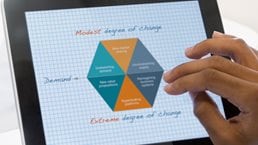The digital revolution is coming to the power industry. Renewables, distributed generation, and smart grids demand new capabilities and are triggering new business models and regulatory frameworks. Data collection and exchange are growing exponentially, creating digital threats but also valuable opportunities. The competition for customers is shifting to the online channel; the Internet of Things promises new product and management options. Entrants from the digital economy are disrupting the industrial landscape, while governments and regulatory bodies seek to encourage smarter measuring systems and greener standards for generation and consumption.
To thrive amid these challenges, the utility of the future will be a fully digital system. This means that today’s utilities face a digital transformation of their organization and business. This can begin with quick moves to improve efficiency and expand the customer base. As the transformation builds momentum, it should open deeper digital opportunities across a wide field.
Potential at every level
The opportunities are present all along the power-industry value chain, from generation to customer relationship management (Exhibit 1). As utilities pursue these opportunities, the effects are already being felt by retail customers. Many utilities have launched mobile applications for bill notification, presentment, and payment, as well as for outage management. Before long, mobile applications will extend into smart homes and connected buildings. Digital management of distributed energy resources, from individual sites to entire systems, has already begun. Many projects within the utility have a digital focus and are using techniques of the digital economy, such as agile development.

Not infrequently, however, the potential benefits of such efforts are underestimated. Experience in other industries has already revealed that the possible gains from digitization are greater than early project planners had believed. The US logistics firm United Parcel Service, for example, introduced “track and trace” for parcels in the 1990s, aiming to improve the customer offering. Only later did it become clear that the greater transparency obtained through digitization allowed for better management of parcels, vehicles, and distribution processes. In the end, the company improved efficiency across its entire scope of operations and saved hundreds of millions of dollars.
Would you like to learn more about our Electric Power & Natural Gas Practice?
Based on the experience of other industries, utilities can begin with more ambitious digital goals. They can plan confidently for transformative enhancements in productivity, reliability, safety, customer experience, compliance, and revenue management. The dimensions of these exciting opportunities can be understood in three developmental waves, comprising productivity and efficiency, the customer experience, and new frontiers.
Improving productivity and efficiency
Digital opportunities to improve operations and increase flexibility are available throughout the value chain (Exhibit 2). Conservative estimates supported by analysis of real-life cases suggest that digital optimization can boost profitability by 20 to 30 percent. Utilities can realize most of this potential by three means: smart meters and the smart grid, digital productivity tools for employees, and automation of back-office processes.

Smart meters and the smart grid. These innovations form the foundation of the digital utility, supplying the massive volumes of data that are its lifeblood. For utilities invested in the right analytics capabilities, they enable data-based analyses, planning, and diagnostics. Smart grids are more efficient and less capital intense, allowing for predictive maintenance and better asset health. Smart meters are a requirement for the advanced credit and collections algorithms that can identify which customers will need help to avoid default. The array of means used to better analyze existing information ranges from local diagnostic tools to highly complex planning instruments. With such tools, utilities can optimize staffing levels at power plants and manage the intricate energy terrain of renewable and conventional sources, trading options, and patterns in demand.
Productivity tools for employees. Mobile enablement for employees is quickly becoming a powerful productivity-boosting capability. Since smartphones provide the platform, grid companies can now digitize the core process of work management to greater effect. This means better asset management, engineering, planning, scheduling and dispatch, as well as execution and job closeout. Since the 1990s, this process has been managed through enterprise-resource-planning systems, which have generally been unwieldy—easy neither to use nor to extend to scale. With the latest digital and mobile technology, utilities can more easily incorporate all work into a single view with universal access. In Germany, one energy supplier has already successfully completed a digitization program and now applies a full tool kit to improve the productivity of its maintenance personnel. GPS and traffic information have been added to conventional route planning and management tools, which increased productive hours by 15 percent. All employees carry a diagnostic tool giving access to reference samples, root-cause analysis, and the range of available replacement parts. They can use the tool to make direct contact with experts if more complex error patterns are detected. Engineers will eventually be provided with information about potential maintenance contracts for customers.
Automation of back-office processes. Administrative processes in customer management and billing (including changes in provider, address, or product) are proliferating. Distributed generation and multiple channels are resulting in more convoluted and error-prone processes. The rewards of process standardization and automation are therefore growing. Process-efficiency opportunities are also evident in the significant variation among retail providers in cost per customer, the cost of resolving errors, and billing inquiries. In one case, a company digitized a single core process and cut process costs by 20 percent in the first year while also improving customer satisfaction. The key drivers were higher-quality data and effective process automation.
Advanced analytics and the multichannel customer journey
Utilities in competitive retail territories as well as traditional regulated environments are struggling to retain customers and fend off new threats in distributed generation. By digitizing the customer experience, utilities can simultaneously improve satisfaction and lower costs. In many locations there is also the potential to improve revenue. In recognition of the opportunity, almost all major energy suppliers have invested in online and especially mobile channels in recent years. While many of the efforts have yielded optimal results, some lag behind with respect to usability and the interface between the online and traditional sales channels.
Most customers prize a multichannel platform that seamlessly connects their interactions across all channels—online, mobile, call center, and local sales. For utilities, the improved customer processes are also more cost effective. Furthermore, a seamless multichannel platform is a requirement for the profitable analysis of customer behavior through the entire customer journey. Utilities are using advanced analytics to enhance service quality, lower costs, and preserve and deepen customer relationships. By using customer data analytics to make process improvements, one northern European energy supplier was able to increase up-selling and cross-selling significantly, while simultaneously increasing usage of its digital channel. Start-ups such as Thermondo in Germany, a provider of highly customized heating solutions, have based their business model on improving various customer interaction points and so are altering business dynamics in the industry.
Following the example of the banking industry, which has demonstrated the predictive power of analytics in customer relationship management, many companies have begun analyzing customer information through machine-based learning. For instance, some are analyzing customer attributes and behaviors, and defining customer groups by predictive criteria such as willingness to pay for specialized services or susceptibility to switching.
New frontiers
The threats to utilities from digital pioneers such as Amazon, Google, or Tesla Motors are most tangible at the customer interface, where information is more important than material assets. All the same, digital capabilities allow utilities to enter new business arenas, whether alone or in partnership.
Distributed generation. Smart meters provide energy suppliers with the exact details of each customer’s generation and consumption. On this basis, tailored products can be developed, such as demand-response programs, which award discounts and rebates to customers allowing utilities to control their heating and cooling. Utilities are also entering into maintenance contracts that provide distributed facilities with improved service based on data analysis. Eventually, the utilities could own the distributed facilities and sell optimized hours to facility operators and other customers. In such models, the combination of customer proximity, technological competence, and digital capabilities becomes a powerful competitive advantage.
Efficiencies in energy and facility maintenance. The formidable economic advantages of energy efficiency have been pursued mainly by large energy-intensive industrial companies. This is because the methods for identifying opportunities and installing solutions have been costly and labor intensive. With smart-meter usage expanding, these costs could plummet. The efficiencies depend on the acquisition of copious detailed information on power usage by commercial and residential customers. This information is now at the ready. Partnerships among real-estate companies, plant manufacturers, and energy suppliers could be a winning model, by which utilities take on a design-based role, with direct access to data on consumption and generation.
Smart homes, connected buildings, smart cities. Many utilities already offer solutions for networked energy management that include the remote control of buildings. Utilities can use information from smart meters to realize additional applications in this new business area, alone or with partners. Municipal, regional, and national governments are launching smart-city initiatives, aimed at promoting technical innovation and systematic applications of the Internet of Things in urban landscapes. Utilities are partnering with cities and builders to implement sensing technology and data analytics in “self-learning” buildings, as part of integrated municipal energy and environmental planning.
Digital transformation ahead
To realize these digital opportunities, utilities need to transform operations. To begin, they must develop a digital transformation strategy that can be successfully embedded and scaled in the organization. It should be designed around the company’s existing value drivers and strengths, including the product portfolio, technical competence, and customer proximity. Projects and partnerships must be designed with the linked objectives of digitizing core processes, upgrading IT platforms, and conquering new business terrain.
By their very nature, digital transformations also bring about a cultural shift. The business horizons for utilities have traditionally been of long or medium duration, and for good reason. The industry is based on the use of expensive assets requiring serious investment and taking account of regulatory factors. With the rise of distributed generation, alternative energy sources, and the data-driven customer interface, utilities are intersecting an information-based digital economy. Here success depends on new capabilities, especially the rapid scaling of innovations. As they plan to meet the digital challenge, utilities can fortunately draw on a wealth of experience from recent change programs in diverse industries. Essential success factors are discussed in the following set of topics.

Strategy in a digital age
Our series on developing corporate and business-unit strategies in a digitally disrupted world.
Digital vision and positioning
Digitization is changing industry boundaries and dynamics. In articulating their digital vision, companies must first identify the position they want to occupy on the digital terrain, with respect to data, services, and devices. More precisely, this means finding the points in the value chain where digitization would make the largest revenue contribution in the next year or two. The key action areas for digital transformations are outlined in Exhibit 3. By systematic analysis, companies can learn the value opportunity of each area and the feasibility of attainment. With clarity on the expected changes, companies can develop a digital blueprint and lay the groundwork for its successful implementation.

Transformation and technique
Elevate the importance of design. As Apple and Google products infinitely attest, simplicity of design and especially user-friendly end products count for a lot in the digital economy. Successful digital transformations are clearly dependent on adoption and usage. To strategy and technology—the two main work streams of traditional business transformations—design must therefore be added as a third prerequisite of the digitization effort. The postmortem review of user experience is not the best path to adoption success. End users, whether customers, suppliers, or employees, must help shape the design from the onset and provide continuous input into the usability and usefulness of any proposed digital effort.
The agile approach. The design requirement is tightly linked to the movement to an iterative agile management and development philosophy. The agile approach to change is based upon a culture of sharing, open communication, and visible support from top management. It improves design by using cross-functional teams to understand end users more deeply and meet their needs more nearly. Unlike in a conventional engineering approach, the teams work by an iterative test-and-learn principle. Top management would do well to afford these teams the greatest possible freedom when it comes to taking action, since experience shows that agile teams foster digital success.
Start with the end user. An end-user orientation supports the elevated role of design and the agile approach. When digitizing business processes, companies that have been most successful have begun with the end user and worked backward. This orientation helps ensure that initiatives are undertaken according to their value and the corresponding need for change. The orientation demands a clear understanding of the end-user journey and the potential value lying therein. Once they understand how customers interact with them from touchpoint to touchpoint, many utilities alter their management approach. By moving from a focus on functions or products to an orientation toward the customer journey, utilities can unlock significant value. After analyzing the customer journey, one company streamlined its product portfolio by 30 percent and established a customer-friendly digital channel for its core products. One result was a 10 percent increase in customer satisfaction.
Establish two-speed IT. Digital transformations must go forward in an environment of the existing IT architecture and processes. These stably support the large transactional systems that enable the day-to-day operations of the business. The agile test-and-learn approach, on the other hand, requires an IT environment that can flexibly respond to changes in portals, mobile apps, and other aspects of the end-user interface. For the success of most digital transformations, therefore, two-speed IT architecture is needed. Its creation is the most important contribution the IT department can make to the transformation. Once a team is established and the underlying agile management philosophy is articulated, the work quickly proceeds to decisions about mobile platforms, development tools, and new talent recruitment.
Define targets and link budgets to progress. Successful companies set clear targets for their digitization efforts—to earn, for example, a certain share of revenue through digital channels in a fixed amount of time. Clear targets require concrete budgets. Approaches where short-term progress can be measured easily with performance indicators, such as customer growth, have been particularly successful. As in sectors such as private equity, the approach grants additional funding to successful projects, while identifying lagging projects for modification or termination.
As daunting as digital transformation programs might appear to individual companies, the potential opportunity is worth many times the attending cost and risk. Eventually, every utility will have undergone digital transformation. The change is furthermore spreading in every industrial sector. Digital-forward sectors such as retail and financial services have already demonstrated that the value in digitization is greater than anyone predicted. For utilities, transformations can yield productivity improvements, revenue gains, better network reliability and safety, enhanced customer acquisition and retention, and entry into new business areas. The mounting pressure to transform also offers the rare opportunity to rebuild strategies, structures, and processes from the ground up. The companies that take it will be ready for future market challenges.


